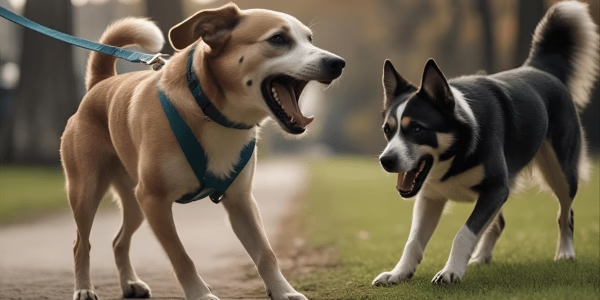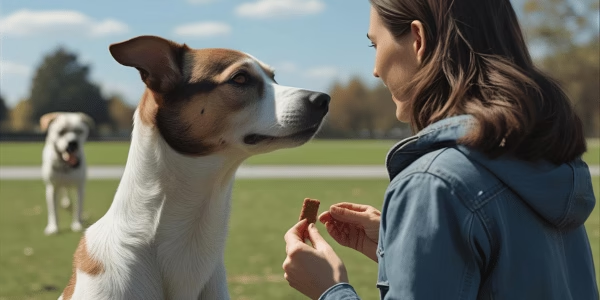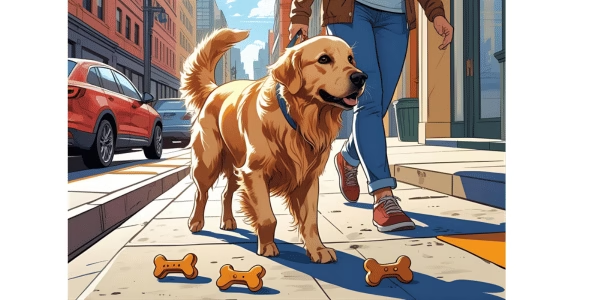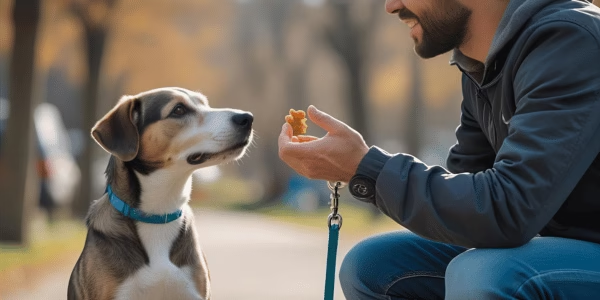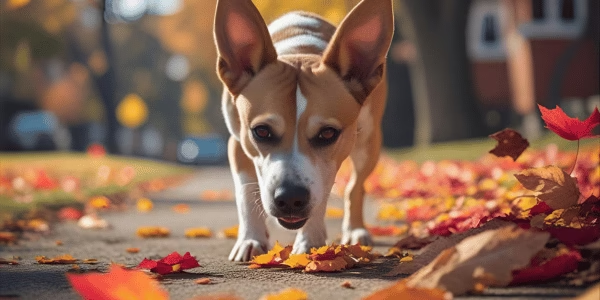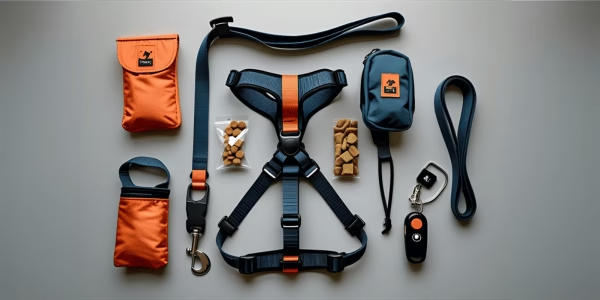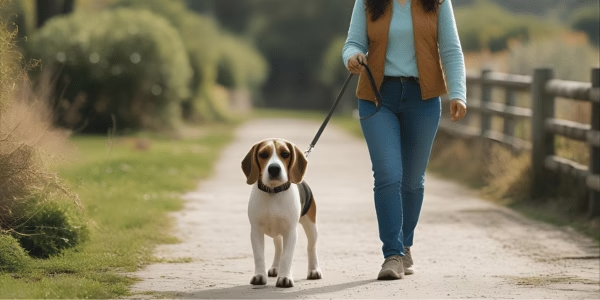This post contains affiliate links and You Site Name is a member of the Amazon Services LLC Associates Program. Which means we may receive a commission from purchases made through links at no extra cost to you. Learn more on our privacy policy page.
Walking a reactive dog can be one of the most stressful experiences for dog owners. You set out for a peaceful walk, only to be caught off guard when your dog lunges, growls, or barks uncontrollably at another dog, a jogger, a child on a bike, or even a trash can.
But here’s the good news: with the right techniques rooted in positive reinforcement, you can help your reactive dog stay calm and focused on walks, reducing both your stress and theirs.
This guide dives deep into evidence-based leash training methods for reactive dogs, helping you rebuild confidence one walk at a time.
What Is a Reactive Dog?
A reactive dog is one that overreacts to certain stimuli, often while on a leash. Unlike truly aggressive dogs, reactivity is usually fear or frustration-based. The dog becomes overstimulated, leading to an outburst of barking, lunging, or growling.
Common Triggers for Reactivity:
- Other dogs
- Strangers or groups of people
- Loud or sudden noises
- Vehicles, bikes, scooters, or strollers
- Unfamiliar environments or situations
While leash reactivity is the most common type, reactivity can also occur in other settings (like behind fences or in cars).
Why Use Positive Reinforcement for Leash Training?
Punishment-based methods (e.g., prong collars, leash corrections, yelling) may stop a behavior temporarily, but they don’t address the root cause, and often increase fear and stress.
According to the American Veterinary Society of Animal Behavior, positive reinforcement is the most humane and scientifically proven way to train dogs, especially those with fear-based issues like reactivity.
Benefits of Positive Reinforcement:
- Builds a trusting relationship
- Replaces fear with positive associations
- Helps dogs make better choices on their own
- Promotes long-term behavior change
- Increases confidence in both dog and owner
Positive reinforcement works by rewarding desired behavior, which increases the likelihood your dog will repeat that behavior in the future.
How to Get Started: Foundations of Positive Reinforcement
Before you step out the door with a reactive dog, you need to lay some groundwork.
1. Choose High-Value Rewards
Reactive dogs need motivation to stay focused. Use treats your dog doesn’t get during regular meals. These could include:
- Freeze-dried liver
- Boiled chicken
- String cheese
- Soft jerky-style dog treats
- Dog-safe peanut butter (in a squeeze tube for quick delivery)
2. Train in a Low-Stimulus Environment First
Your dog can’t learn if they’re already over threshold (i.e., too anxious or reactive to focus). Start in:
- Your backyard
- Inside the house
- A quiet parking lot
This helps your dog succeed and builds the habit of checking in with you around distractions.
3. Timing and Consistency Matter
Mark the behavior the moment it happens. Use a clicker or a consistent word like “Yes!” to pinpoint what you’re rewarding.
Deliver the treat within 1–2 seconds to reinforce the association clearly.
Positive Reinforcement Leash Training Techniques for Reactive Dogs
Let’s break down the most effective, science-backed techniques you can use immediately, and build on over time.
RELATED: Pet Training Guide: Raise a Well-Behaved Pet with Ease
Technique 1: Look at That (LAT) Game
This popular technique, developed by trainer Leslie McDevitt, helps reactive dogs learn to calmly look at their triggers rather than overreact.
How to play:
- Position your dog at a safe distance from the trigger, far enough that they notice but don’t react.
- The moment your dog looks at the trigger, say “Yes!” or click.
- Immediately reward your dog.
- Your dog will start to glance at the trigger, then look back at you for a treat.
This changes the emotional response from “I need to bark at that dog!” to “When I see a dog, I get rewarded!”
Progressive tip: Gradually decrease the distance over multiple sessions as your dog becomes more comfortable.
Technique 2: 1-2-3 Treat Pattern Game
Created by Dr. Amy Cook, this structured game creates predictability and keeps your dog engaged.
How it works:
- As you walk, count aloud: “1, 2, 3.”
- On “3,” drop a treat at your dog’s feet or deliver it from your hand.
- Repeat the rhythm every few steps, especially if a trigger is nearby.
Dogs love predictable patterns, and this technique redirects their focus to you and away from triggers.
Technique 3: Counter-Conditioning and Desensitization
This classic behavioral technique is the gold standard for changing how your dog feels about a trigger.
Example process:
- Start with your dog at a distance where they notice the trigger but aren’t reacting.
- When the trigger appears, give continuous high-value treats until it disappears.
- No treats when the trigger is gone.
- Gradually reduce the distance over time.
Eventually, your dog will associate the trigger with something positive rather than fear or anxiety.
Technique 4: Emergency U-Turn
Sometimes, the best thing you can do is leave the situation.
To teach it:
- While walking, say “U-turn!” in a cheerful tone.
- Use a treat to lure your dog to turn with you and walk away.
- Practice frequently in calm environments.
When needed during real walks, your dog will know that “U-turn” means fun, rewards, and safety.
Technique 5: Engagement Training (“Watch Me” Game)
Teaching your dog to look at you on cue helps them stay focused when distractions are present.
How to teach:
- Hold a treat near your face.
- Say “Watch me.”
- When your dog makes eye contact, mark and reward.
- Gradually increase duration and add distractions.
Use this cue proactively when you spot a trigger approaching.
Technique 6: “Find It” Game
This fun and easy game keeps your dog’s nose and brain busy, a great way to shift focus.
How to play:
- Say “Find it!” and toss a treat on the ground.
- Let your dog sniff it out.
- Repeat several times to engage your dog’s nose (which naturally reduces stress levels).
This game is especially useful as a preventive tool when a trigger is getting closer.
Visual: Progress Timeline for Reactive Dog Training
Here’s a simplified view of how progress often looks when using positive reinforcement.
| Week | Goal | Distance from Trigger | Dog’s Behavior |
| 1 | LAT Game | 40+ ft | Notices dog, then looks at owner |
| 3 | Add mild distractions | 25–30 ft | Begins to auto-check-in |
| 5 | Move to moderate triggers | 15–20 ft | Calm body, no lunging |
| 8 | Walk near dogs in park | 10 ft | Controlled focus and no reaction |
Note: Every dog progresses at their own pace, don’t rush.
Training Progression Timeline: From Foundation to Advanced
Training a reactive dog is a journey. Here’s a roadmap to guide you through steady progress—from the basics to advanced control.
- Weeks 1–2: Foundation Skills
- Master “Look at Me” in distraction-free zones.
- Practice “Leave It” with treats and low-level stimuli.
- Introduce clicker or marker word for rewards.
- Weeks 3–5: Controlled Exposure
- Begin the LAT (Look at That) game far from triggers.
- Reinforce calm focus with high-value treats.
- Keep walks short and positive; monitor stress signs.
- Weeks 6–8: Moderate Distance Practice
- Gradually reduce distance to common triggers while rewarding calm behavior.
- Introduce more distracting environments in low-stress contexts.
- Practice emergency U-turns when needed.
- Weeks 9–12: Near Trigger Mastery
- Walk in busy parks maintaining controlled focus within 10 feet of triggers.
- Use engagement games to sustain attention.
- Begin managing real-world distractions without reacting.
- Month 4 and Beyond: Maintenance and Refinement
- Practice skills with variable frequency and intensity.
- Occasionally revisit easier scenarios to build confidence.
- Continue rewards but begin transitioning to intermittent reinforcement.
- Seek professional coaching if progress stalls.
Remember: Every dog’s timeline varies. Consistency, gentle pacing, and patience are your keys to success.
What Tools Do You Need?
Avoid tools designed to punish (prong collars, e-collars, retractable leashes). Instead, opt for equipment that supports learning and safety.
Recommended Gear:
- Front-clip harness: Like the Ruffwear Front Range
- 6-ft sturdy leash: Provides control without restricting movement, we recommend the Taglory Rope
- Treat pouch: Keep your rewards accessible (Mighty Paw Treat Pouch)
- Clicker: For precise timing during training
RELATED: Clicker Training Guide: A Fun & Effective Way to Train Your Dog
Safety Protocols and Emergency Procedures
Safety first: training should prioritize your and your dog’s well-being. Here’s how to stay safe if things go wrong.
Proper Gear for Control
- Use a sturdy front-clip harness to reduce pulling and improve steering.
- Opt for a 6-foot leash for balance between control and freedom.
- Carry high-value treats and a clicker for timely rewards.
Emergency Tools
- Keep a treat pouch easily accessible.
- Have a spare leash and collar available.
- Consider a calming vest (e.g., ThunderShirt) for severe cases.
Emergency Procedures
- Spot a trigger too close? Use “U-turn” immediately. Calmly direct your dog to turn away and reward compliance.
- If your dog lunges unpredictably: Do not pull harshly; increase distance and give calming cues.
- If your dog bites or fights: Safely leave the situation and seek professional help. Avoid physical punishment—it worsens anxiety.
- Know your limits: If a walk becomes unsafe, cut it short and try a less stressful time or location next time.
Always prioritize safety for all involved. Prevention and preparation reduce emergencies, but quick, calm reactions save the day.
How to Handle Setbacks
Progress isn’t linear. Dogs will have bad days, and so will you.
What to do:
- Don’t punish your dog for reacting, it increases anxiety.
- Increase distance from triggers if your dog reacts.
- Go back a step in training to rebuild confidence.
- Keep sessions short and positive, always end on a win.
If progress stalls, consult a Certified Applied Animal Behaviorist (CAAB) or a Fear Free Certified Trainer.
Troubleshooting Common Reactive Scenarios
Even with solid training, reactive dogs can hit rough patches. Here’s how to tackle common challenges.
- Dog lunging and barking at other dogs: Increase distance, revert to basic “Look at Me,” and reward calmness. Avoid escalating tension by keeping your voice calm and body relaxed.
- Reaction to joggers, bikes, or strollers: Preempt triggers by watching the environment closely. Use the 1-2-3 Treat Pattern Game to focus your dog before the trigger appears.
- Overwhelmed in busy or crowded areas: Shorten walks or head to quieter zones. Use “U-turn” to remove your dog from stressful spots and reward relaxation.
- Failure to respond to cues under stress: Go back to lower-distraction settings to rebuild reliability. Increase reward value temporarily and keep training sessions short.
- Owner frustration impacting training: Recognize your own stress signs; take breaks when needed. Practice deep breathing or mindfulness to maintain calm, which your dog will pick up on.
Success Story: Benny the Barky Beagle
Benny, a 4-year-old beagle, barked wildly at every dog within 100 feet. His owner, Sarah, began using the LAT game and 1-2-3 Treat Game daily. They practiced in quiet neighborhoods before working up to dog parks (from a distance).
After three months of consistent positive reinforcement, Benny could walk past most dogs without reacting. He even made a few new dog friends, something Sarah never thought possible.
Her biggest takeaway? “I stopped trying to suppress the barking and started rewarding calm choices. That’s when everything changed.”
Real-Time Tools and Resources
Here are some highly recommended resources and trainers who specialize in positive reinforcement for reactive dogs:
- Karen Pryor Academy
- Fear Free Happy Homes
- DogDecoder App, helps you read dog body language
Final Thoughts
Positive reinforcement leash training is not just about teaching your dog how to behave, it’s about changing how they feel about the world around them.
By using kindness, consistency, and science-backed techniques, you’ll empower your reactive dog to make better choices and build a stronger bond in the process.
Remember:
- Start slow
- Reward often
- Stay patient
Because with the right approach, every reactive dog can learn to walk with confidence.


